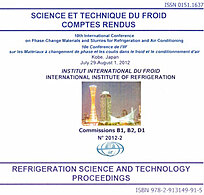
Document IIF
Évaluation des propriétés de base des coulis de glace.
Estimating basic properties of ice slurries.
Numéro : pap. K01
Auteurs : MELINDER Å.
Résumé
Aqueous solutions are used as single-phase secondary fluids in indirect refrigeration systems to transport energy and some of these fluids are suitable for certain two-phase ice slurry applications. Several requirements are to be fulfilled by an ideal ice slurry fluid such as energy transport, pumping power and heat transfer. This paper gives enhanced enthalpy phase diagrams as a function of additive mass fraction as well as other charts with equilibrium values of enthalpy change and ice mass fraction (both related to energy transport), density, viscosity (related to pumping power) and thermal conductivity (related to heat transfer), as function of freezing point for aqueous solutions of ethyl alcohol, ethylene glycol, propylene glycol and sodium chloride. Isothermal lines, that can represent operation temperatures, and lines for some temperature differences below the freezing point may help to determine the best choice of additive and operating conditions. These charts are based on properties of ice and of the aqueous solution as well as simple equations for liquids with solid spherical particles. A comparison is made of the four types of aqueous solution as ice slurry and single phase fluids. The fluid should also be non-corrosive, non-toxic, non-flammable, chemically stable and biodegradable.
Documents disponibles
Format PDF
Pages : 12 p.
Disponible
Prix public
20 €
Prix membre*
Gratuit
* meilleur tarif applicable selon le type d'adhésion (voir le détail des avantages des adhésions individuelles et collectives)
Détails
- Titre original : Estimating basic properties of ice slurries.
- Identifiant de la fiche : 30004978
- Langues : Anglais
- Source : 10th International Conference on Phase-Change Materials and Slurries for Refrigeration and Air Conditioning. Proceedings: Kobe, Japan, July 29-August 1, 2012.
- Date d'édition : 01/07/2012
Liens
Voir d'autres communications du même compte rendu (46)
Voir le compte rendu de la conférence
-
Recent advances in thermal energy storage and t...
- Auteurs : INADA T.
- Date : 01/07/2012
- Langues : Anglais
- Source : 10th International Conference on Phase-Change Materials and Slurries for Refrigeration and Air Conditioning. Proceedings: Kobe, Japan, July 29-August 1, 2012.
- Formats : PDF
Voir la fiche
-
Thermophysical properties of nanoemulsions as a...
- Auteurs : FUMOTO K., KAWAJI M., KAWANAMI T.
- Date : 21/08/2011
- Langues : Anglais
- Source : Proceedings of the 23rd IIR International Congress of Refrigeration: Prague, Czech Republic, August 21-26, 2011. Overarching theme: Refrigeration for Sustainable Development.
- Formats : PDF
Voir la fiche
-
Experimental study of thermal characteristics o...
- Auteurs : CAI X. M., SONG W. J., XIAO R., et al.
- Date : 21/08/2011
- Langues : Anglais
- Source : Proceedings of the 23rd IIR International Congress of Refrigeration: Prague, Czech Republic, August 21-26, 2011. Overarching theme: Refrigeration for Sustainable Development.
- Formats : PDF
Voir la fiche
-
Development of phase change material containing...
- Auteurs : CHOI D. H., KIM J. Y., KANG Y. T.
- Date : 25/06/2012
- Langues : Anglais
- Source : 10th IIR-Gustav Lorentzen Conference on Natural Working Fluids (GL2012). Proceedings. Delft, The Netherlands, June 25-27, 2012.
- Formats : PDF
Voir la fiche
-
Determining the rheological behavior of octadec...
- Auteurs : DELGADO M., GSCHWANDER S., LÁZARO A., et al.
- Date : 01/07/2012
- Langues : Anglais
- Source : 10th International Conference on Phase-Change Materials and Slurries for Refrigeration and Air Conditioning. Proceedings: Kobe, Japan, July 29-August 1, 2012.
- Formats : PDF
Voir la fiche
